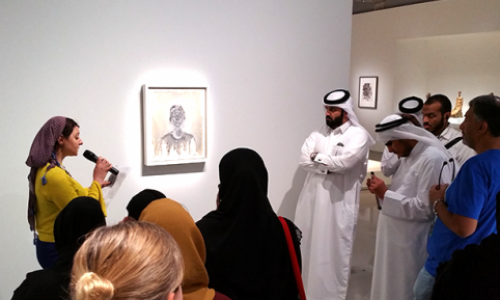
Convergence Point: HBKU Students Apply Audiovisual Translation Technology to Make Art Accessible to the Visually Impaired
Convergence Point: HBKU Students Apply Audiovisual Translation Technology to Make Art Accessible to the Visually Impaired

When Pablo Picasso was born in 1881, Thomas Edison’s incandescent light bulb had just been unveiled to the worldand electricity will not be a common household fixture for another three decades.In the preceding years, as new technologies continued to revolutionize civilization across the globe,artistswere interested in technology as source material for their work. They painted landscapes with smokestacks, textile machines and their operators, cranes used in coal mining, or the railroad barreling across open country– in this age, art and technology were parallel lines.
By the time Picasso died in 1973, he was regarded as a grand master of art and credited with creating Cubism. Then, art seemed immune from technology, but the art world Picasso was leaving behind was no longer going to remain insulated or independent from technology. Today, the realmsof art and technology havecollided and become inextricably intertwined.
In 2017, this marriage between art and technology has led to the digitization of art, virtual galleries, online auctioneering, 3D printed sculptures, and art that is accessible to the visually impaired.
As a research intensive university in the region, Hamad Bin Khalifa University’s (HBKU) College of Humanities and Social Science’s (CHSS) students are pioneers in this ongoing intermeshing of art and technology. Delivered by CHSS’s Translation and Interpreting Institute (TII), the Masters of Arts in Audiovisual Translation students train to become specialists in the mediation of audiovisual texts, integrating the fields of technology, culture, and linguistics.
In May this year, several HBKU students interned at Doha’s iconic Fire Station Artist in Residence facility to work on an exciting new project using audio tactile transcreation. This meant that HBKU students helped to create audio descriptions and touch replicas for Qatar Museums’“Giacometti and Me” exhibition. The exhibition featured some of Picasso’s famous pieces and sculptures by the renowned Swiss artist Alberto Giacometti – which included works like Self Portrait, Woman Throwing a Stone, The She Goat, Danger, Tall Woman, and Walking Man, amongst others.
Over the course of their internship, HBKU students spent their time analyzing the exhibits that required audio-visual support, scripting the walk-through of the exhibit in the blind-accessible script, Braille, and produced replicas for touch-based exploration. Their work successfully captured the essence of Picasso’s colorful artwork and his rich portrayal of the human condition for the visually impaired. They were also successful in conveying the beauty, shapes, and curves meant to evoke the shocking realism of modernity Giacometti wished to present his audience with.
“At HBKU, we offer our students internship opportunities at local and global leading institutions, giving them the opportunity to work with experts and put into practice their academic training,” mentioned Dr. Amal Mohammed Al-Malki, Founding Dean of CHSS. “Students gain exposure into the professional setting and are able to implement the new approaches, whether theoretical or practical, and the new technologies acquired through their studies. The human capital of the next generation will establish the rules of the future through relevant and innovative future approaches.”
The interns had the opportunity to work closely with students from the Al Noor Institute for the Blind while researching and developing the accessible visitor guide for the visually impaired. By the conclusion of the project in late May, the students from HBKU’s College of Humanities & Social Sciences showcased their work and received valuable actionable feedback from visitors – especially members of the Qatar Social and Cultural Centre for the Blind.
Dr. JoseliaNeves, Associate Professor at HBKU and internship advisor to the students, noted: “It was an extraordinary experience for our interns to be working at the Fire Station Artist in Residence facility, which is really the beating heart of Qatar’s vibrant community of local and international artists. Our students were buzzing with fresh ideas to heighten the experience of Picasso and Giacometti’s worktothose with visual impairments by enabling them toexperience and enjoy the art as it was intended to by the grand masters.”
Second year student pursing her Masters of Audiovisual Translation, Malak Latrous was one of the interns from CHSS working on the special project with Qatar Museums. Malak said that the internship experience was “a chance to put into practice what [she] learned throughout the semester in a real life work situation.” She said, “I got the opportunity to work on projects that proved how vital translation in general, and audiovisual translation in particular, is to society.”
Technology is no longer just a source material for art in this era, but an active agent in facilitating our understanding of the art presented to us at galleries and museums.Through diligent efforts by pioneers at places like HBKU, contemporary and classical works of art are now more accessible than ever. Art and technology are no longer running in parallel lines, but converging at multiple pointsacross Qatar and elsewhere.
To learn more about HBKU’s Audiovisual Translation program, or other programs offered in humanities at CHSS, click here.







